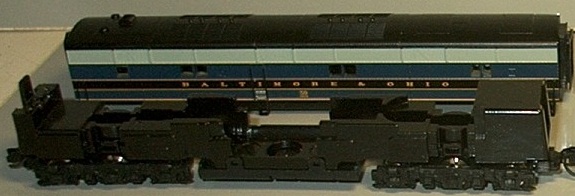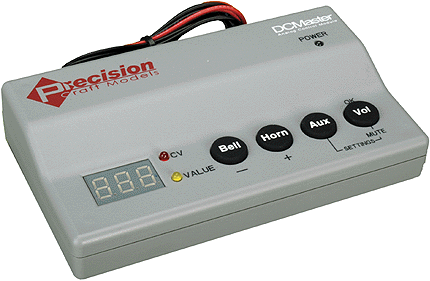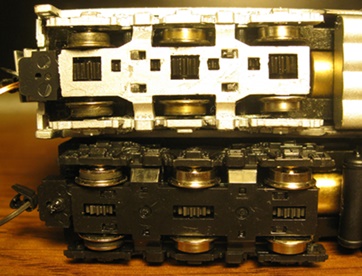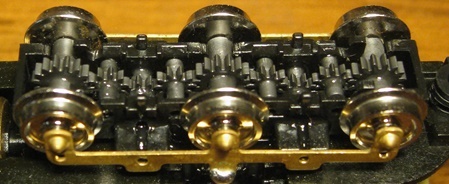





Introduced: 2006 (Precision Craft E7), 2009 (Broadway Limited E7/E8), 2014 (Paragon2 E7/E8), 2018 (Paragon3 E7/E8) and 2024 (Paragon4 and Stealth E7/E8)
These models have a somewhat convoluted history. The first run (E7A and E7B models) came in "Precision Craft Models" packaging (PCM's first N scale release). Unfortunately, said E7s were not particularly well received by the N scale community (IE, slow sales). As far as I know, said negativity was not due to any sort of dissatisfaction with the models themselves. Rather, it was due to the odd choice of prototype (did we really need another E7?), along with a certain disenchantment with the way PCM conducted their business (announcing locomotive projects and then only proceeding with them if they received enough pre-orders to justify the project). But whatever the reasons for the slow sales, the end result (seemingly) was that PCM basically put the brakes on all their other planned N scale locomotive projects (thus further damaging their image).
Well, along came 2009 and PCM did finally release their announced E8 A and B models (along with a second run of E7s). And oddly enough, said models came in "Broadway Limited Imports" packaging (and with only one tiny mention of Precision Craft in the small print). Now, many have speculated that the name change was actually an attempt to get around the ill will built up towards the PCM brand. However, the real reasons are a bit more mundane. The PCM name was actually used to differentiate products using LokSound decoders from the Broadway Limited items that used QSI decoders. The two different types of decoders require different proprietary control boxes when used in analog/DC mode, and consequently, the PCM/BLI packaging dichotomy was used to keep the product lines separate (and thus avoid consumer confusion). However, now that BLI has their own advanced DCC/DC sound decoder (Paragon), the need for the PCM name probably no longer exists.
In any case, I think that first run of E7's made for a rather impressive debut. They take paint and detailing to a whole 'nother level for N scale diesels. The separately applied handgrabs are far superior to anything I've ever seen from any other manufacturer. The couplers provide for some seriously close coupling. The flexible diaphragms are a new feature I've never seen on any other diesel. And overall, they're just really gorgeous models.
The powered units are available either "DCC-Ready" or with factory-installed "dual mode" DCC sound decoders. Non-powered "dummy" units are also available.

The chassis is a one-piece chunk of metal and quite hefty. The motor is a closed-sided, skew-wound 5-poler (with dual flywheels). Ten of the twelve wheels provide pickup (with the rearmost two wheels being equipped with traction tires). Pickup is of the "low-friction" ilk, with current transferred to the main PC board by lots and lots of wiring. The PC board controls directional lighting as well as providing sockets for a decoder and speakers. All wheels are geared and all gearing is plastic. All couplers are Micro-Trains. The pilot coupler on the "A" units is mounted to the chassis, whereas all the rest of the couplers are truck-mounted. All wheels are blackened and low-profile. "A" units have a cab interior detail insert that holds a small LED-equipped PC board for the headlight and Mars light.

"B" units have a slightly different chassis, with a large chunk of metal chassis replacing the cab area found on "A" units. Consequently, shells will not interchange between A and B units.
The DCC-Ready models (powered, but no decoder) are basically the same as the sound-equipped versions, with the only real difference being the decoder socket on the PC board (a standard 8-pin NMRA-style socket, versus the 21-pin socket on the sound-equipped models). Dummy models use the same basic metal chassis as the powered units, just sans motor, driveshafts, flywheels, gearing and lighting. Unfortunately, said metal chassis does tend to turn them into boat anchors -

Overall performance is solid - smooth running, nimble throttle response, superb slow-speed creep, reasonable top-end, and with pulling power to spare. I've never had any problems with stalls (even through turnouts) or with any of the wheels derailing (even on 9.75"-radius curves).
The DCC sound feature is quite impressive. All the various sounds are advertised as being "authentic" and, as far as I can tell, they are (not that I'm any kind of expert, mind you). The dual speakers make for nicely beefy sound affects (or at least as beefy as you're ever likely to find in something this small). Even more impressive is the fact that sound is available on non-DCC layouts (being "dual-mode", these locomotives will run equally well in DCC and analog modes). So, you can fire these things up with your 1945 trainset transformer and listen to those engines crank up and go just as well as anyone with the latest DCC system can. OK, you do need a special add-on widget (pictured below) to take advantage of the non-automatic sound features (ringing the bell, blowing the horn, etc), but whatever. The fact that non-DCC guys can take advantage of any of these digital features is just plain amazing to me.

OK, having said all that, I do have a couple of gripes (and hence the "B" rating). First of all, these do make a bit more noise than what we're used to nowadays. Nothing horrible, but there is definitely some extraneous gear (or traction tire) buzzing going on as these things roll along. Next, I'm not real impressed by the fact that they went with wires to transfer current from the trucks. Admittedly, I've been running mine for years and haven't experienced any wiring-related problems. Still, you just never know with those things. And in any case, they make truck removal a much more arduous task than it needs to be. Also, I'm a little disappointed by the fact that the couplers are (for the most part), truck-mounted. Although, it's kind of hard to argue with the resultant close-coupling.
One last quibble is with the way these things stop. Cut the power (in analog mode) or quick-drop to speed step 0 (in DCC) and these things will come to an abrupt halt. They have flywheels, so I'm not sure what that's all about. When you start moving, they are absolutely prototypical - the sound revs up and they gradually start moving. And when throttling down to step 0 in DCC-mode they do come to a gradual stop (accompanied by a very cool brake squeal sound affect). However, this is definitely decoder-aided behavior. The flywheels themselves don't appear to have any affect at all on starting and stopping - IE, no "Kato Glide" here.
So, basically what we have here are great looking models that perform adequately.
Trivia - Despite PCM's claims to the contrary, their E7's were not the first N scale locomotives to come with factory-equipped DCC sound (that honor goes to Con-Cor's 2003 PA release).


The Broadway Limited E7 and E8 models (IE, second-run) have the same basic chassis / mechanism as the first-run E7 models. However, the decoder is completely new (now "Paragon2" instead of "LokSound"). Also, the speaker situation is completely different (one speaker in an enclosure instead of two unenclosed speakers). On the DCC-Ready units, the NMRA plug is on top of the PC board (as opposed to the first run models, which had the DCC plug on the bottom of the PCB). My BLI E8s run basically the same as my PCM E7s - smooth, but a little buzzy.
One problem I did run into is with the lubrication. The trucks on my UP E8's came absolutely slathered in oil, which quickly got all over the wheels (and the track, and everything else). Not surprisingly, it didn't take more than a few minutes of operation before the things were stalling out all over the place. Not a huge deal, though. I cleaned the excess oil off the trucks and wheels, hooked up a track cleaning car, and after a few minutes of operation everything was hunky dory.
In addition to the excess lubrication, the "blackening" crud on the wheels can interfere with pickup rather drastically as well (at least at first). I had to run my C&NW E7 around in circles for several hours before all the stalling problems cleared up (at which point said crud had presumably worn off). Hooking your E's to a track cleaning car or two and highballing them around for a while seems to take care of the conductivity problems pretty well. However, even with the wheel-blackening worn off, they do remain a bit more finicky about dirt (either on the wheels or on the track) than do most diesel models. I find that I have to remain extremely vigilant about keeping things clean with these PCM/BLI models, as they will start to act a bit balky on track that other diesels can traverse without problem.
The sound on these Paragon2 decoders is quite impressive. Despite the single speaker, I'd say overall sound quality on these models is a bit more robust than produced by the earlier LokSound-equipped locos (probably due to the speaker enclosure). And the array of different sound FX available is almost bewildering in its variety and sheer number. I mean, "ambient farm sounds"? Um, OK...
One problem with the Paragon2 decoders is that they are not compatible with all DC power supplies. For example, my MRC Railpower 1300 will not operate these locos at all (the lights come on, but no sound and no motor). BLI informs me that the only solution to the problem is to either purchase one of their DC Master boxes or switch power supplies. MRC's Tech 3 and Tech 4 throttles reportedly have no problems running these locos. Another problem with Paragon decoders in general is that they seem to be more prone to melting down than do other decoder brands. So far I've had three Paragon2 decoders give up the smoke on me (around a 50% failure rate). Consequently, I can't rate the Paragon-equipped models any higher than a "C".
These models were revised a bit with the 2014 release. First off, the decoder board was flipped over (not sure why, but maybe less stuff sticking up and hitting the shell this way?) -

Additionally, the truck gear boxes were completely redesigned (old E7 on top, new E8 on the bottom) -

Lastly, the old stainless steel axle wipers (with the tiny washers and the axle holes drilled all the way through) were replaced with more traditional dimpled phosphor-bronze wipers. Also, the wheel-blackening stuff was left off -
| Old E7 | New E8 |
 |  |
The wheel and wiper changes were a couple of very good ideas (making for much more effective and reliable pickup). As for the gearing changes... well, about all that served to do was drastically increase the top-end speed (up to nigh Kato-esque levels). Consequently, if your idea is to run one of the older models with one of the newer ones, you're going to have to tweak the decoder CV's in the newer one in order to slow it down a bit.
A note on paint removal - the paint on these models is unlike anything I've ever encountered before (some sort of powder-coat or plating scheme, I'm not sure), and traditional paint removal methods simply will not work (believe me, I've tried them all). I checked with BLI and they informed me that it is virtually impossible to strip the paint off their models without damaging the shell in the process. So, if your aim is to custom paint one, you're either going to have to go with an undecorated unit or paint right over the top of a decorated unit.
A note on undecorated units - BLI's E8's (and possibly their E7's, I'm not sure) have a number of prototype-specific details (pilot type, grill type and headlight configuration). However, during any given production run BLI only manufactures a single configuration for their undecorated models. So, if you're planning on acquiring and painting an undecorated model (and are fussy about the detailing), you're going to have to check inside the box to see what sort of details are included therein.
A note on the 2018 (Paragon3) release - these new decoders provide support for BLI's "Rolling Thunder" external sound system.
A note on the 2024 (Paragon4) release - this production run also included DCC-Ready "Stealth" versions that come with a Next18 DCC interface on the DC motherboard.

Prototype information (E7) -
Most of the premier passenger trains including the AT&SF "Super Chief," various CB&Q "Zephyrs," Great Northern's "Empire Builder," New York Central's "Twentieth Century" and Pennsylvania Railroad's "Broadway Limited" were pulled by EMD "E" unit diesel locomotives from the 1940's to the 1970's. The largest percentage was the E7's with 428 units produced between February 1945 and April 1949. The railroads developed a love affair for the E units until most passenger trains on major railroads were powered by one of the bulldog nose diesel locomotives. Modelers have long been infected by the same bug as the railroads were. When passenger trains became too long for a single E7A unit, most railroads added additional E7A's to gain enough power to handle such trains. A few railroads opted to have cabless locomotives built: E7B's, which could be controlled from the A unit. The "B" suffix indicates a booster unit. The railroads that used E7B locomotives included: PRR, Union Pacific, Southern Pacific and New York Central.
Prototype information (E8) -
The E8's are 2250 HP passenger train locomotives manufactured by General Motors Electro Motor Division in La Grange, Illinois. Between 1949 and 1953, EMD produced 421 E8A units and 39 B units. In the E9's, they increased their horsepower to 2400. In appearance, the E8's and E9's are nearly identical. Most railroads purchasing E7's also purchased E8's. Toward the end of their service, E8's and E9's were used for commuter and even freight service.
Model Features (BLI E7 and E8) -
- ALL-NEW Paragon Sound & Control System
- Integral DCC Decoder with Back EMF for Industry Best Slow Speed Operation in DC and DCC
- Precision Drive Mechanism engineered for continuous heavy load towing and smooth slow speed operation
- Motor Type: 5-Pole Can with Skewed Armature & Dual Fly Wheels
- Premium Caliber Painting with Authentic Paint Schemes
- Prototypical Light Operation with Golden White LED Headlight and Cab Light
- Beautifully Detailed, Accurately Modeled Locomotive
- Separately Applied Details such as grab irons, steps, and ladders
- Operating Sprung Diaphragms
- Constant Intensity Directional Lighting
- Traction Tire-Equipped for Maximum Traction
- Locomotive Composition: ABS with Die Cast Chassis
- A-Unit Length: 5.1"
- B-Unit Length: 4.9"
- A-Unit Weight (Powered): 4 oz
- Couplers: (2) Micro Trains #1015
-Recommended Minimum Radius: 9.75"
Sound Features (BLI/Paragon2 E7 & E8) -
- Operates in DC & DCC (use DCMaster for DC Sound)
- Record & Play Operation - Records and plays back sounds and movements once or repeatedly for automatic operation
- 16-bit Sample Rate for exceptional high frequency sound clarity
- Playback Whistle for multiple whistle lengths and patterns
- Choice of 3 selectable Whistles / Horns
- Alternate Whistle / Horn where applicable for locomotive with air horn and steam whistle - both the main whistle and alternate can be easily played
- Adjustable bell ringing interval for faster or slower bell
- Numerous user-mappable functions with available keys
- Johnson Bar Sound at Direction Change (Steam Only)
- Passenger Station Ambient Sounds - Controlled with Function Key
- Freight Yard Ambient Sounds - Controlled with Function Key
- Lumber Yard Ambient Sounds - Controlled with Function Key
- Farm Ambient Sounds - Controlled with Function Key
- Crew Radio Communications - Controlled with Function Key
- Maintenance Yard Ambient Sounds - Controlled with Function Key
- Demo Mode for display and demonstrations
- Grade Crossing Automatic Signal 8 Diesel Motor Revs (Diesel Only)
- Simple Programming with Integral DCC Decoder
- Automatic Forward / Reverse Signal - When activated, stopping triggers and stop whistle toot. When moving forward from a stopped position,
toots twice. When moving in reverse. toots three times.
- Engine sound intensity varies with load Individually adjustable sound volumes for each effect
- EZ Reset Button for quick return to factory default settings
To remove the shell, simply spread the sides apart and lift. Removing the pilot coupler from an "A" unit is not necessary, although it does simplify things.
Grade: B (for the PCM and Stealth versions) and C (for the Paragon versions)
First-run E7 reviewed 11/06 Model Railroader ("These great-looking N scale EMD E7 passenger diesels are smooth-running models that not only look like their prototypes, they even sound like the real locomotives. The well-detailed locomotives are produced by Precision Craft Models with dual-mode DCC and sound decoders from Electronik Solutions Ulm. The E7s are also offered in DC-only versions without decoders, but they include an NMRA socket for a future DCC upgrade... PCM's E7 is an all-new model with a well-proportioned plastic body that has prototype-specific flat or angled number boards, exposed or enclosed coupler pilots, and single or dual headlights. The details are excellent with tiny, well-formed rivets and side screens. These E7s match prototype drawings... The mechanism and electronics are packed into every bit of space within the body shell. This model is built on a one-piece cast zinc-alloy frame that provides most of the weight for traction. A five-pole can motor is recessed into the fuel tank, leaving room overhead for the electronics and speakers...
"This model has a neatly designed, low-profile mechanism that fits entirely in the lower half of the body. The can motor is mounted on its side; the dual flywheels, drive shafts, and truck gearboxes also fit into openings in the frame. The six-wheel trucks have all of their axles powered... The nickel-silver RP-25 contour wheels are mounted on tubular axles... Both units have traction tires on their rear axles to boost pulling power. Contacts concealed in both sideframes collect current from all of the wheels, and they're hard-wired to the PC board. These E7s are fitted with dual-mode LokSound V3.5 decoders from ESU... The ESU decoder offers an array of up to 20 realistic sounds and lighting effects, including some that operate automatically... The ESU decoder offers other interesting DCC features, including a constant speed control that maintains speed without regard to the engine's load or grade... A dynamic drive uses back EMF at slow speeds to provide smooth low-speed performance in both the DC and DCC operating modes. A comprehensive 12-page operating manual comes with these models...
"At full throttle, the single E7A unit pulled 27 freight cars (9 passenger)... Adding the B unit doubled the consist's drawbar pull. Both A and B units have individual sound systems... Operating these models with sound is a lot of fun - it's hard to believe how much volume is produced by the tiny speakers... These E7s are great-looking models with powerful mechanisms and excellent sound. Any N scaler who models postwar passenger trains will enjoy hearing these tiny EMDs rev up as they begin another trip. B&O, CB&Q, GN, NYC, PRR, SP, UP, Undec. A unit with sound and DCC: $239, DC only $129, dummy $79, B unit with sound and DCC: $229, DC only $119, dummy $74")
Broadway Limited E8 reviewed 12/09 Model Railroader ("The rumble of 12-cylinder 567B engines and many other realistic sound effects highlight this Digital Command Control (DCC) sound-equipped E8 diesel in N scale from Broadway Limited Imports. The locomotive includes BLI's new Paragon2 sound decoder and operates on DC and DCC layouts. The dimensions of the BLI model match drawings in the Model Railroader Cyclopedia, Vol. 2: Diesel Locomotives (Kalmbach Publishing Co., out of print). Lettering and striping placement of the model's red-and-silver warbonnet livery match prototype photos. Other molded details on the plastic body shell match prototype photos. Separately applied parts include etched-metal side grills and sprung end diaphragms.
"A can motor and two brass flywheels are enclosed in the lower half of the frame. Gearboxes above the trucks transfer power to all six axles. The rear wheels of the rear truck have traction tires, helping the engine achieve an impressive 1.6 ounce drawbar pull. The DCC decoder is mounted on top of the rear half of the frame. A single downward-facing speaker in a plastic enclosure is mounted on top of the front half of the frame. Two light-emitting diodes (LEDs), one for the headlight and another for the Mars light, are attached to a separate printed-circuit board mounted to the front of the cab interior assembly.
"In DCC the model includes 28 user-triggered functions. Along with the horn and bell, I enjoyed functions 4 and 5, which allow you to adjust the engine RPM level independently of the locomotive speed. I also appreciated function 7, which turned the Mars light on or off independently of the headlight. The engine sounded like recordings of 567 diesels that I've heard. I liked the default horn sound, but if you disagree, there are two other horn sounds available.
"The model performed smoothly in our DCC speed tests. After programming CV5 (maximum voltage) to a value of 80, the model achieved a more prototypical 110 scale mph top speed. I tested the BLI E8 in DC using an MRC Tech 4 power pack. Out of the box, the headlight came on at 6 volts (V), but as I advanced the throttle the sounds didn't function and the model wouldn't move. To fix this so I could run the engine required a BLI DCMaster Analog Programmer ($39.99, sold separately), which allows you to program CVs on a DC layout. I programmed the analog motor control minimum voltage (CV252) to a value of 60. I also programmed the analog sound start (CV 131) to 50. The lights and sounds on the model then started at 6V. At 7V the E8 started moving at 2 scale mph. After I programmed the analog motor control maximum voltage (CV251) to a value of 80 the model had a prototypical 110 scale mph top speed. The DCMaster allows you to trigger the whistle, bell and other sound functions. You can run the E8 without the DCMaster and still hear engine and brake sounds. Although the model requires a DCMaster to program it in DC mode, the BLI E8 ran well and sounded great. In DCC mode the model is easy to program and operate. This streamlined diesel features realistic sounds and would look great hauling an N scale lightweight passenger train.")